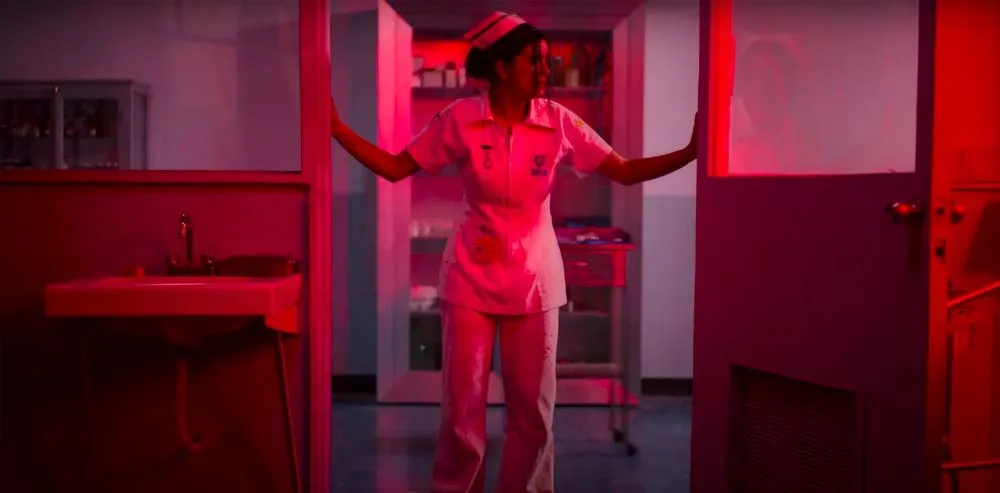“Turno Nocturno: A Disappointing Dive into Mexican Horror”
In the eerie world of Mexican horror cinema, director Rigoberto Castañeda’s latest offering, “Turno Nocturno,” delves into the chilling legend of La Planchada. The film follows Rebeca, portrayed by the talented Paulina Gaitán, as she navigates a haunted hospital plagued by supernatural entities and dark secrets. However, despite its promising premise, “Turno Nocturno” falls short of delivering genuine scares and instead gets lost in a sea of clichés and missed opportunities.
The Story So Far:
Set against the backdrop of the 1970s, “Turno Nocturno” attempts to blend supernatural horror with social commentary on violence against women and the repercussions of misogyny. As Rebeca faces torment from a malevolent spirit and uncovers sinister truths within the hospital, the narrative unfolds with a mix of eerie encounters and dramatic revelations. However, the film struggles to strike a balance between its thematic depth and the execution of its characters, leading to a disjointed and often frustrating viewing experience.
From the performances to the storyline, “Turno Nocturno” fails to capitalize on its potential, leaving audiences with a sense of unfulfilled promise and missed opportunities. Despite the film’s technical prowess and strong ensemble cast, including Adriana Llabrés, Iazua Larios, and Enoc Leaño, the script falters in creating believable character arcs and engaging dialogue. The film’s attempts at conveying a message on women’s struggles in the 70s come across as forced and stereotypical, undermining the depth and impact of its thematic exploration.
As the tension builds and the horror unfolds, “Turno Nocturno” struggles to maintain a coherent narrative, often resorting to shock value and superficial scares rather than building genuine suspense. While the film excels in visual elements like production design, cinematography, and special effects, these technical achievements fail to elevate the overall viewing experience due to a lack of cohesive storytelling and thematic resonance.
Conclusion:
In conclusion, “Turno Nocturno” is a missed opportunity in Mexican horror cinema, failing to capitalize on its intriguing premise and talented cast. Despite its technical achievements, the film falls short in delivering a truly chilling and cohesive narrative, leaving audiences wanting more substance and depth. As the credits roll on this supernatural tale, viewers are left with a sense of unfulfilled potential and a longing for a more refined and impactful cinematic experience.
Frequently Asked Questions:
1. What is the legend of La Planchada?
The legend of La Planchada is a popular Mexican folklore tale about a ghostly nurse who haunts hospitals, often appearing to care for patients before mysteriously disappearing.
2. Who are the main actors in “Turno Nocturno”?
The film features Paulina Gaitán, Adriana Llabrés, Iazua Larios, Enoc Leaño, and Carlos Valencia in key roles, showcasing their talents in this supernatural thriller.
3. How does “Turno Nocturno” explore themes of violence against women?
The film attempts to shed light on the challenges faced by women in the 1970s, highlighting issues of abuse, misogyny, and societal expectations through the experiences of its female characters.
4. What are the strengths of “Turno Nocturno” in terms of technical aspects?
“Turno Nocturno” boasts impressive production design, cinematography, and special effects, creating a visually striking and immersive world that enhances the film’s eerie atmosphere.
5. What are some of the shortcomings of “Turno Nocturno” in terms of character development?
The film struggles with inconsistent character motivations, unrealistic dialogue, and underdeveloped character arcs, hindering the audience’s ability to connect with the protagonists on a deeper level.
6. Does “Turno Nocturno” effectively blend horror and social commentary?
While the film attempts to intertwine supernatural horror with social themes, the execution falls short, leading to a disjointed narrative that struggles to convey its intended messages effectively.
7. How does the direction of Rigoberto Castañeda impact the overall quality of “Turno Nocturno”?
While Castañeda showcases technical proficiency in crafting visually striking scenes, the lack of cohesive storytelling and thematic depth undermines the film’s potential, resulting in a missed opportunity for a truly impactful horror experience.
8. What are some standout moments in “Turno Nocturno” that elevate the film’s horror elements?
Despite its shortcomings, “Turno Nocturno” offers moments of visual terror and suspense, particularly in scenes featuring supernatural encounters, eerie settings, and chilling special effects.
9. How does “Turno Nocturno” compare to other recent Mexican horror films?
“Turno Nocturno” falls short of standing out among recent Mexican horror releases, struggling to differentiate itself with a unique identity and compelling narrative that resonates with audiences.
10. What can viewers expect from “Turno Nocturno” in terms of entertainment value and overall impact?
While “Turno Nocturno” offers moments of intrigue and visual flair, the film ultimately fails to deliver a cohesive and engaging horror experience, leaving viewers with a sense of unfulfilled potential and missed opportunities in its storytelling approach.
Tags: Mexican horror cinema, La Planchada legend, supernatural thriller, social commentary, character development, technical aspects, horror elements, Rigoberto Castañeda, Mexican folklore.

